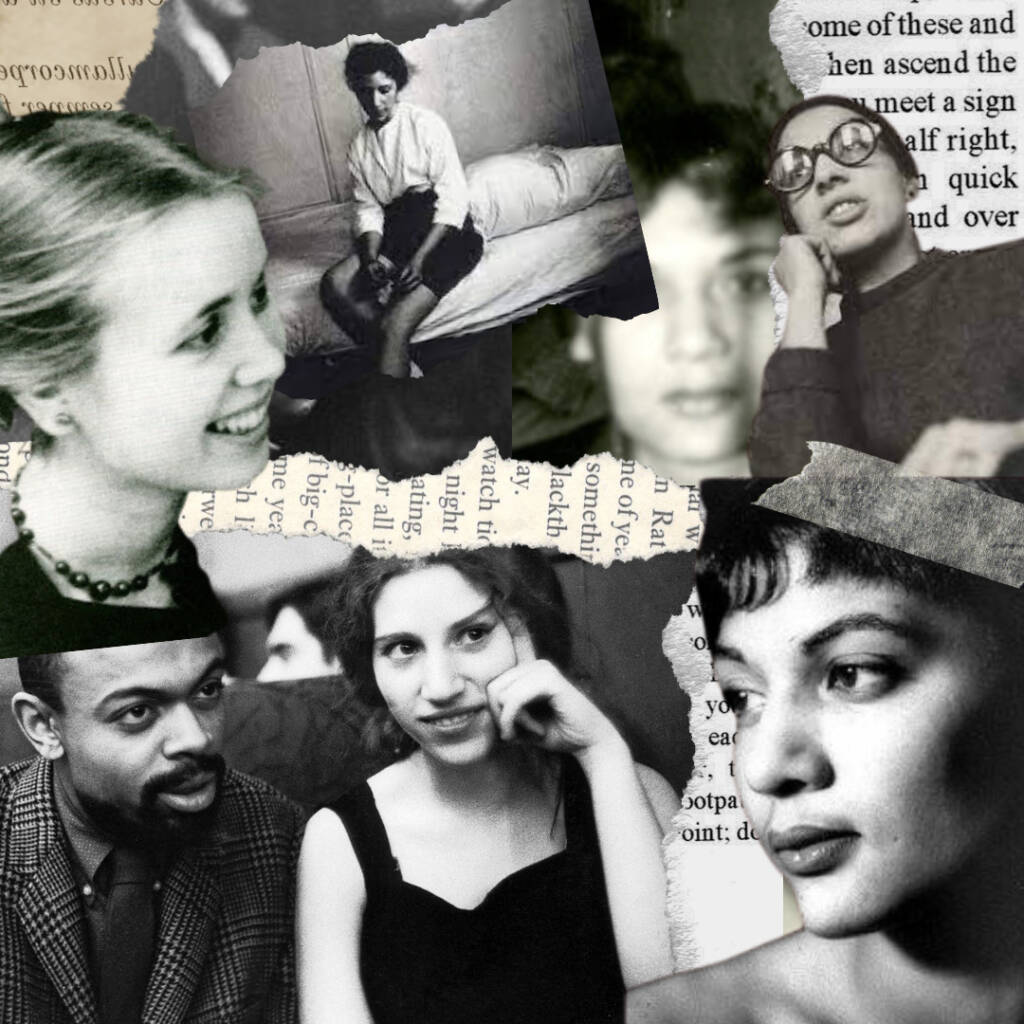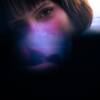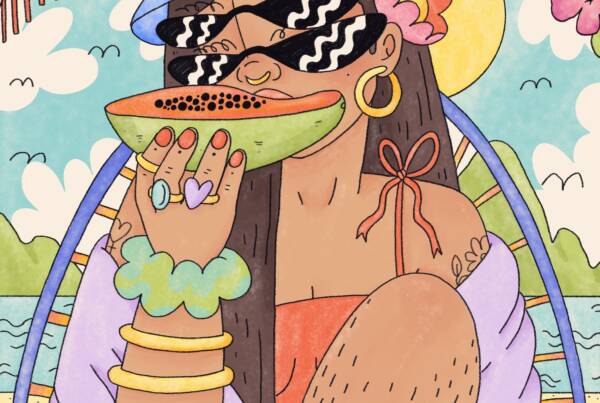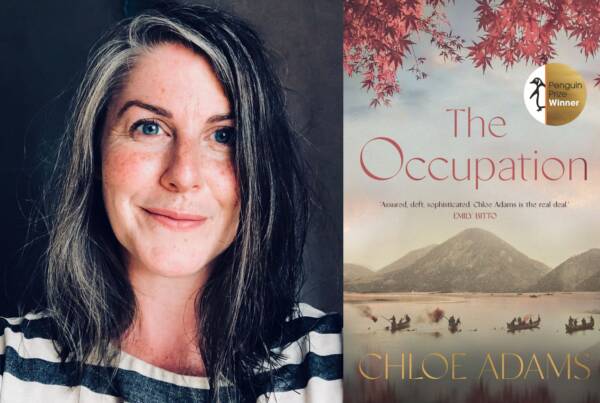Writing by Alexandra Aller
 If you don’t know much about the Beat Generation, the literary era and youth culture movement of the 1950s, chances are you don’t know much about the women of it either.
If you don’t know much about the Beat Generation, the literary era and youth culture movement of the 1950s, chances are you don’t know much about the women of it either.
Some of the more prominent Beat figures that you might recognize from summer reading lists, like Jack Kerouac, William S. Burroughs or Allen Ginsberg, were much like celebrities of their time. They went on to have a long lasting impact on pop culture, mingling with and influencing names like Keith Haring, Patti Smith, David Bowie, Steely Dan, The Sex Pistols. Their work has been remembered, referenced, studied, and adapted into film.
It’s worth noting that what makes reading the Beat writers so exciting is that they referenced one another’s work, utilized similar techniques and even made “appearances” behind pseudonyms. While there are dozens of notable women of the era whose work deserves more attention, there are four female writers whose lives and written work share this same almost divine interconnectedness.
Diane di Prima, Hettie Jones, Joyce Johnson and Alene Lee share more than just the aptitude for the written word. These women blazed trails in the shadows of their male counterparts, faced familial alienation, societal backlash – and laid down much of the infrastructure for the female artists we know and love today.
Alene Lee
At her potential, bolstered and complemented by other great legend-writers of the Beat era, it sounds as if Alene Lee could have been America’s first Black and Native American Female Beat Author. At the least, there might have been mention of her friendship and influence. Allen Ginsberg had said that, “Alene was a peer and we [Kerouac, Burroughs, and Carr] considered her an equal.”
Sadly, much of what we know about Lee today is based on the fictionalized and painfully reduced composite of Mardou Fox, the prostitute-junky-muse or rather, the silent collateral damage of Jack Kerouac’s book, The Subterraneans. Kerouac famously used pseudonyms, but readers and press deciphered identities. What they didn’t catch on to was how Kerouac had quite the knack for romanticizing or some would argue – twisting – the truth. Lee was hounded by the press and would become so reclusive and distrusting of the industry as a whole, that she all but faded away.
Her wikipedia page is curiously sparse. She is excluded from famous collections on Beat Women, like Women of the Beat Generation by Brenda Knight. Her only work ever published was an autobiographical essay titled “Sisters’ unearthed by her daughter Christina Diamente on Beatdom. Diamente claims that Lee was once in talks with Grove Press [the iconic Beat publisher of the era) but was dissuaded by an editor, Fred Jordan, who had said her material was not “commercially viable.”
Alene Lee died in 1991 from breast cancer with Ginsberg by her side. It is said that hundreds of pages written by Lee simply sit sequestered away.
Joyce Johnson
Unbeknownst to the author herself, Joyce Johnson’s first book Come and Join the Dance was in fact the first Beat novel ever written by a woman. It remains an unprecedented depiction of life for a young woman in the 1950s, writing about her sexual explorations and ambitions, two very taboo topics of the times. Then, it hadn’t been that long ago or rather forgotten that a woman could be admitted to a mental institution for nymphomania or “sexual derangement. Mental hospitals were often used to punish and reform both women and “problem” peoples for stepping out of the status quo. Her determination to write and ultimately publish a novel of this nature was both highly unusual and gallant for 1962. Some would say it paved a direct path for Diane di Prima’s Memoirs of Beatnik (with appearances from Ginsberg and Kerouac) published in 1969 (not that its content mimicked Johnson, but rather Johnson’s success led to the literary community’s continued interest in the female gaze on sexuality).
Johnson is however best known for her novel Minor Characters, whose cover shows her standing in the shadow cast by the glowing mystique of Jack Kerouac, the “Grandfather of the Beat Generation,” her then lover and mentor of sorts. Kerouac wrote widely about his romantic escapades and it wasn’t uncommon for the women to later publicly reply through novels of their own. There was his first wife, Edie Parker, his second, Joan Haverty, Carolyn Cassidy, LuAnne Henderson. All of these accounts are significant in that they paint a more nuanced picture of the Beat era, figures and ultimately life for a woman, standing in the aspirational shadows of the Beat men.
Today Johnson has published numerous books, taught creative writing courses at several MFA programs and till this day teaches a memoir workshop in New York City.
Hettie Jones (Cohen)
Pictured is Hettie Jones and Joyce Johnson, fellow infamized Beat women to-be and friends.
Hettie Jones is an American poet who has published twenty-three novels and remains an integral literary figure in New York City, but it wasn’t until her separation from the famous writer & activist, Amiri Baraka, fka LeiRoy Jones, that her words found their wings.
Much of Hettie’s career was actually spent behind the curtains helping to co-found and edit [with her then husband LeiRoy] Yugen, a famous Beat newsletter and Totem press, both devoted to, “A New Consciousness in the Arts and Letters.” She helped to publish important early works and books by Beat figures, including Diane di Prima, whom LeiRoy famously had an affair and child with, while still in wedlock to Hettie.
The scandal between LeiRoy and di Prima often becomes the most lusterful detail in this Beat tale, but there again in the shadow, you can find Hettie Jones’ devotion as a driving force behind LeiRoy’s success. Much like Patti Smith did for Robert Mapplethorpe [Just Kids], Hettie worked for the sake of them both. This provided him the opportunity to create and carry on with his endeavors in order to become the acclaimed Amiri Baraka, poet, author and American civil right activist.
Later LeiRoy would altogether distance himself from the Beats, including Hettie (who had originally been disowned by her family for marrying a black man). He would leave her and their children for a spouse he saw as more suitable to his new path as a black cultural nationalist. Soon after landing on her feet, she began to take up her own writing again and thankfully never stopped.
She too is now a widely regarded American poet and professor of poetry, fiction and memoir.
Diane di Prima
Diane di Prima may very well be the best known Beat woman, some even referring to her as the Beat Queen, but she was also the most dismissed by her community and male peers. The author, poet, editor, artist and theater director had said herself that “she was not often invited to read alongside her peers, despite her central role in that community.” di Prima wrote about feeling slighted during and after the popularization of the Beat era and it’s not surprising seeing as how much of her legacy seems to rebut male ideals and therefore, the male writers who held them.
While Kerouac once egregiously described Beat “girls [who] say nothing and wear black,” di Prima’s existence lived in breathing opposition. Her first book of poems, This Kind of Bird Flies Backward, was published in 1958 just one year after Jack Kerouac’s infamous On the Road.
di Prima was revolutionary of her time and a complex artist, but much like the male Beats, her lifestyle seems to precede her written work. Many readers are fascinated by her winding personal life, famous love affairs, and the many Beat microcosms she existed within.
Sadly di Prima passed away in 2020, but she was awarded the National Poetry Association’s Lifetime Service Award and the Fred Cody Award for Lifetime Achievement. Her work is highly regarded and beloved, but frankly still often only finds recognition in female readership.
–
There are dozens of Beat women who made lasting legacies in their respective fields, but it’s hard not to wonder about how many other women still wait in the shadows. As Gregory Corso said, “There were women, they were there…In the 50’s, if you were male, you could be a rebel, but if you were female, your families had you locked up… I knew them. Someday someone will write about them.”
For now, we can read them. Limiting our knowledge of the Beat era, even the base of it, to just its prolific male figures, is knowingly swimming in the lacuna of imperative historical context and fact. The spectrum and cultural impact cannot be done justice without its hidden figures, the women of the Beat Generation.






